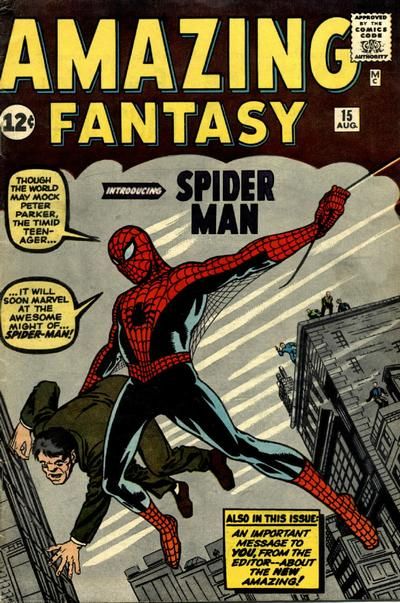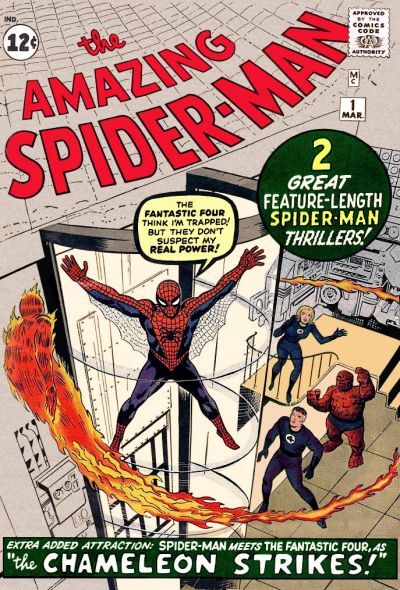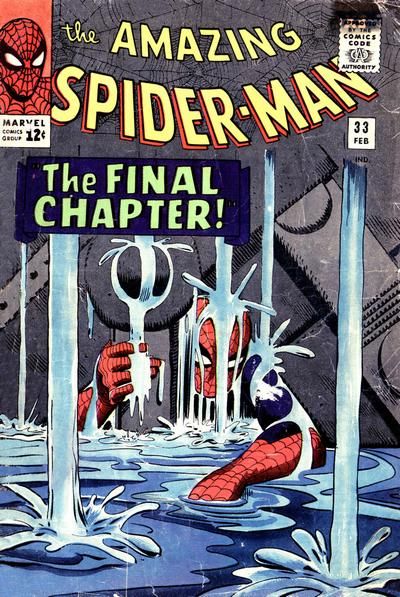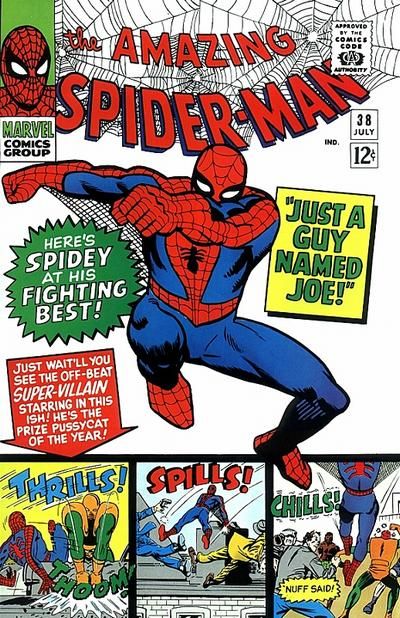Okay, let us see which run ended up at #6, thereby ruining about 75% of all top five guesses!
Enjoy!
6. Stan Lee and Steve Ditko's Spider-Man - 926 points (19 first place votes)
Amazing Fantasy #15, Amazing Spider-Man #1-38, plus two Annuals
Introduced in the last issue of the anthology, Amazing Fantasy (which had its name changed from Amazing Adult Fantasy to Amazing Fantasy in the last issue), Spider-Man quickly got his own title, also written and drawn by Stan Lee and Steve Ditko.
Really, it is extremely hard to quantify the impact of this run by Lee and Ditko, particularly on Ditko's end, who soon became the driving force behind the comic strip during probably the greatest period of comics in Marvel's most famous superhero.
During this period, characters who were introduced include Spider-Man, Aunt May, J. Jonah Jameson, Flash Thompson, Harry Osborn, Gwen Stacy, Betty Brant, Liz Allen plus pretty much every notable Spider-Man villain - Dr. Octopus, Electro, Sandman, Mysterio, The Vulture, and one of the most notable villains - the Green Goblin.
Ditko's style was one of great economy, so readers got a great deal of story in every issue of Spider-Man, and Ditko manages to make the book so realistic and so down-to-Earth, which was aided greatly by Stan Lee's clever dialogue, which made the stories a great deal more appealing to the populace than they would have been if Lee was not present.
Perhaps their greatest moment on the title happened towards the end of the run, with the classic storyline that was so influential that it must have been homaged about three gazillion times since then - where Spider-Man is trapped under heavy rubble and is forced to fight against all odds to escape with the cure for Aunt May (suffering one of her many illnesses).
Such a brilliantly told story.
Ditko's last issue was Amazing Spdier-Man #38...
Here is my pal Michael Pullmann on why this run was #1 on his list:
Stan Lee likes to tell the story that he took his pen name because he wanted to write the Great American Novel one day under his own name, and didn't want it associated with his work in comics. What Stan, or anyone else, could never foretell was that he would go on to write, with Steve Ditko, the Great American Graphic Novel, the tale of Peter Parker, the Amazing Spider-Man, serialized in Amazing Fantasy 15 and Amazing Spider-Man 1-33 and Annual 1-2.
You didn't read that wrong, True Believers; the Spidey story as told in those issues comprise a classic mid-20th Century American Bildungsroman. Peter Parker as portrayed in these issues joins the ranks of Huckleberry Finn, Holden Caulfield, Valentine Michael Smith, and more, as he journeys from being the "Timid Teenager" to Marvel's greatest hero, and, more importantly, a man.
As Amazing Fantasy 15 begins, Peter is, well, a twerp. Obsessed with science, socially awkward, and more than a little solipsistic, he is not the stuff of heroes. Even after the spider bite, his abortive career as a novelty act, and even Uncle Ben's tragic fate, he's still a callow, untested youth. The very first panel of Amazing Spider-Man 1 shows Peter throwing a tantrum in his room, tossing his mask to the ground and wishing he'd never become Spider-Man. But he doesn't stay that way for very long; duty and the growing pile of unpaid bills on Aunt May's desk call, and so he ventures out unsteadily into the world to make his way the only way he can think of: as Spider-Man.
Danger and defeat taunt him at every corner: J. Jonah Jameson begins his eternal smear campaign that bans him from the variety shows and brands him a criminal; Vulture, Dr. Octopus, Sandman, and even Dr. Doom all hand him devastating defeats; he's consistently shown up by the brash and more popular Human Torch, whose cavalier attitude is mirrored in Peter's perpetual high school nemesis, Flash Thompson. And yet, he perseveres; in just the first ten issues, he courageously risks his own life to save others, builds the confidence to begin dating the lovely Betty Brant, and says "farewell" to those pesky coke-bottles when he challenges Flash to a boxing match in the school gym.
And so it continues, success and setback. The defeat of Doc Ock creates the death of Bennett Brant. The first meeting of the Spider-Man Fan Club ends in disaster as Peter runs out on a fight with the Green Goblin to rush to the ailing Aunt May's side. The friendship and rivalry with the Torch solidifies, even as Peter ducks and avoids the attentions of Liz Allen and constant blind dates with the mysterious Mary Jane Watson. Victory over the Sinister Six drives yet another wedge between Peter and Betty. A full scholarship to college lands Peter once again in unsure territory, as he meets and snubs Harry Osborn and Gwen Stacy.
And all of it builds to an unforgettable climax, where, as Aunt May lies dying of radiation poisoning from a transfusion of Peter's own blood, Spider-Man battles the crime lord Master Planner, alias his old enemy Doc Ock, in an undersea laboratory, for the rare isotope that can save May's life. Trapped under a massive piece of machinery, with seawater rushing into the base in torrents, Peter faces the Hero's Choice as never before: Die, and end the struggle, or live, and stand tall as a man of honor and dignity. The moment when he lifts that machinery off of his back, straining muscle and sinew like never before, is the climax, not just of this issue, or this story, but of Peter's entire life to this point. Afterwards, we see that he is not the same person, as he tosses off Dr. Bromwell's concerns for his health with grim determination, gives Jonah an ultimatum that leaves the old publisher speechless, and silently accepts that he's lost Betty for good. Greater adventures and loves are yet to come, but the Story of Peter Parker, the Boy Who Called Himself A Man, has reached its conclusion. The tired but triumphant hero limps off into the night, now and forever worthy of the name that will pass into legend: Spider-Man.
It's an age-old story told from the point of view of the unlimited possibilities of the 1960s, given life by two great artists at the top of their game. It's the Marvel Way of Storytelling in microcosm, a comics epic as never seen before or since. It's an inspiration to generations of young readers as callow and afraid as Peter, about to step forth into the uncertain world of adulthood. It's a friggin' humongous $99 hardcover.
It's the Story of Spider-Man, and it's my favorite comic book run of all time.
Thanks, Michael!
Okay, tomorrow - the top five begins!!






